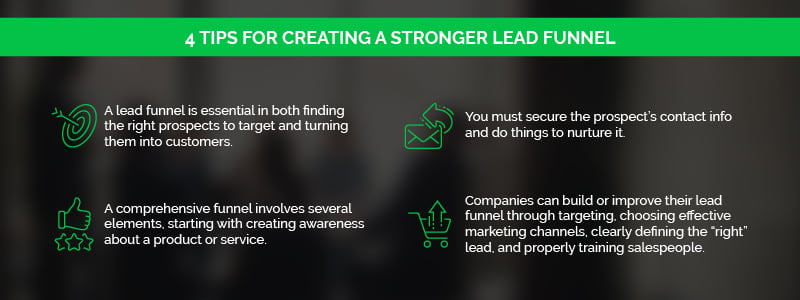4 Tips for Creating a Stronger Lead Funnel

Your sales funnel is the lifeblood of your business. Learn more about the vital components of a successful one and how to make yours better.

There are simple truths that have always existed in business: For example, if you have a great product or one that solves a common problem better than what’s currently out there, you’ll have little trouble selling it. The issue today is that there are so many businesses in operation and offering so many services to consumers that it can be difficult to stand out.
Very few salespeople knock on anybody’s door to peddle their wares, and consumers tend to be less receptive to the practice if they do. Most companies have websites and marketing plans to get their advertisements to the masses. That means you need new ways to reach potential customers, differentiate your offerings from those around you, and provide information that convinces interested parties to buy something.
It’s up to salespeople to do that convincing, and this needs to start with a lead funnel.
First of all, what’s a lead funnel?
The goal of any company is to identify the perfect audience for what they’re offering, and the lead funnel plays an important role in this. Think of a lead funnel like an upside-down pyramid with the largest part at the top. Your marketing and sales efforts bring people into the funnel, and your messaging and tactics move them through it. The largest number enter as interested parties at the top, and the smallest number convert to paying customers at the bottom.
The more potential customers you bring into the funnel, and the more targeted you are with your efforts, the more likely you are to have leads convert. The trick is continually adding people to it. The funnel includes the steps that are part of their journey, which ends (ideally) with a sale. There are several components that need to be included when building a successful funnel.
The elements of a lead funnel
The first components of a lead funnel involve marketing, and eventually sales will take over. Here’s what you need to know about effective sales funnels.
Awareness
Your message and product need to get in front of the people you hope will purchase from you. Nobody will be beating down your door to buy your products and services if they don’t know about them, right? You need to get the word out through blog posts, social media, pay per click (PPC) advertising campaigns, and any other avenues that will resonate with potential customers.
Lead capture
Once somebody expresses interest in your company, it’s time to bait the hook. You want their contact information so you can keep in touch with them, and you can get it by giving them some high-quality incentives. One example is offering a free e-book that only requires a prospect to enter an email address.
Nurturing
If somebody has willingly given you their contact information, you know they are at least a little interested in your business. Now you have to turn these leads into prospects, and this involves nurturing. Sending out regular emails promoting your blog posts or videos can be very effective.
Qualifying the lead part 1
The final role of the marketing department is to get this prospect to do more. This could involve requesting a quote or scheduling a demo. This qualifies the lead and sales takes over.
Qualifying the lead part 2
The first thing a salesperson needs to do is figure out if this lead is a good prospect. Marketing and sales departments sometimes disagree on this. If sales decides the person isn’t ready, they may be sent back to the nurturing part of the funnel.
Selling opportunities
Once you have a good lead, it’s time to identify opportunities to sell. This involves building a relationship and looking for ways to create engagement, which may include both digital and in-person communication.
Customer
The lead buys from you, if all goes well, making them a full-fledged customer. While technically the last step in the lead funnel, companies shouldn’t stop there. They need to consistently find ways to delight customers so they keep buying – and perhaps encourage others to do the same.
How to build a better lead funnel
The first step is understanding what a lead funnel should include. Now, it’s time to build one or revamp the one you’re currently using.
Step 1: Choose the right leads
A scatter-shot approach used to be par for the course in marketing and prospecting. This could help find some customers, but it also wastes time and money. The better tact is to target the people most likely to want what you’re selling. Creating customer personas is a great way to find your target audience.
Step 2: Go to where they are
Once you know who your potential customers are, it’s time to go where they are. With so much data available, figuring out which social networks, websites, ads, and other items your prospects use and engage with isn’t very difficult.
Step 3: Get sales and marketing on the same page
There are long-storied feuds between sales and marketing departments, but they need to agree when it comes to leads. A pipeline clogged with low-quality leads wastes sales’ time and makes marketing look bad. Defining “quality” is vital, and using lead scoring can be a big help.
Step 4: Supply the right training
People are more discerning than ever about how they spend their money. A salesperson needs to know how to seal the deal, and they need the right training to do so. In addition to the ins and outs of your product or service, this should include information on the psychology of sales and other things to help them become better salespeople.
If you need assistance with that final step – getting your salespeople well-trained – MetaGrowth Ventures can help. Our team is in business to ensure you have the top salespeople working for your company, helping you achieve the growth you need to succeed. We can also implement a monitoring system to track their performance. Contact us to learn more.
Written by
Joe Arioto
